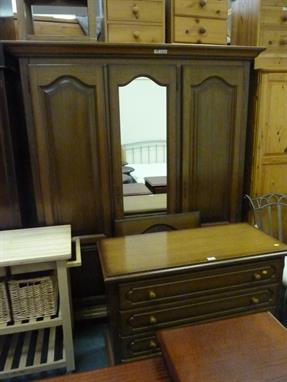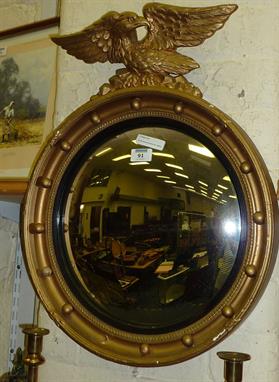We found 402728 price guide item(s) matching your search
There are 402728 lots that match your search criteria. Subscribe now to get instant access to the full price guide service.
Click here to subscribe- List
- Grid
-
402728 item(s)/page
A pair of Regency carved giltwood circular wall mirrors, one with concave glass, the other with convex glass, the frames with bead and gadroon decoration, 31cm diameter (2) CONDITION REPORT: Both have deterioration to mirror plates - more apparent on the concave one. Small losses to paint. Split to frame of convex mirror. Backs have been removed. Softwood.
A silhouette, of a lady with a cat, 19 x 15cm, another in a circular frame, comprising vignettes of animals and figures, 20cm diameter, and a third painted on a mirror backing, 16 x 21.5cm (3) CONDITION REPORT: Lady has areas of staining and loss to fine thread in silhouette. Mirrored example has some deterioration to both paint and mirrored surface.
A George II carved and painted mirror, c.1750, in the manner of John Vardy, the rectangular glass plate within a heavily carved frame of lilies, flowers and bearded masks below female caryatids, the cresting with a Bacchic head surmounted by pierced foliage, 163cm high 96.5cm wide This mirror is conceived and executed with a boldness and vigour which suggests the work of a top-flight London carver. It combines stock rococo motifs such as foliage and pierced plumes, with others more reminiscent of neo-Palladian designs; it is a combination which suggests an intriguing design lineage. The caryatid figures topped by baskets of fruit appear to have been taken from plate 51 of Isaac Ware's 'Designs of Inigo Jones and Others' (1731). According to Ware's list of contents, this Kent design was for a chimney piece for the Saloon at Houghton Hall. Only the lower part was executed and it remains in situ; the upper section, including the caryatids, was never realised, being discarded in favour of a painting, the Baptism of Christ by Franceso Albani (now in the Hermitage Museum, St Petersburg). Similar caryatids with one arm outstretched adorn the Prince of Wales's state barge, which Kent also designed. The satyr's mask atop the mirror, with its distinctive 'feathery' pointed ears, first occurs in a design by Inigo Jones for a chimney piece at Somerset House, c.1630, which was later engraved and published by John Vardy in 'Some Designs of Mr Inigo Jones and Mr William Kent' (1744). The wild-eyed, 'winged' heads on the lower part of each side probably derive from a similar late Mannerist/Italianate source, now lost. On the other hand, the pierced shell or plume cresting, the bunched rushes or palms to either side and the pierced rocaille foliage to the base are all unequivocal indicators of the 'French' or rococo taste which emerged in England from the late 1730s onwards. This combination of neo-Palladian and rococo influence occurs in some of Matthias Lock's early work, for instance the table and looking glass made for Hinton House, Somerset, in 1745. These are now on display in the V&A British Galleries. However, there are also parallels with John Vardy's designs for Spencer House in the 1750s, in particular his tables and pier glasses for the Palm Room. One of Vardy's more idiosyncratic motifs was the beaded acanthus leaf, which appears prominently on the Palm Room mirrors and on the present lot, at the top of the mirror. A similar combination of palm branches and beaded acanthus can be seen on the pair of mirrors designed by Vardy for the Duke of Bolton in the 1760s. Vardy was a protégé of William Kent, being appointed Clerk of Works at Greenwich in 1736 before taking on, successively, Hampton Court, Whitehall, St. James's and Kensington. He is best known for his engraving and publication of designs by Inigo Jones and William Kent cited above. The significance of a potential Vardy connection is that it links the mirror to a select group of carvers working for the King, the Office of Works and other high status clients. One such was James Richards, Master Carver and Sculptor in Wood at the Office of Works, 1721-67. As well as his work at the various royal palaces and government offices, Richards carved the Prince of Wales's state barge and worked for numerous aristocratic clients, most of whom had social or political connections to Lord Burlington and his circle. Another possible author is James Whittle (fl.1731-59), carver to the Prince of Wales. Whittle's work has been documented at Deene Park, Woburn Abbey, Petworth, and Holkham. It is known he produced mirror frames and other work to designs by William Kent and, perhaps more importantly, he employed Matthias Lock, 'a most excellent Carver, and reputed the best Ornament draughts-man in Europe'. Unless documentation or further evidence comes to light, these hypotheses will remain unproven, but the quality of the design and execution is self-evident. We would like to thank Dr. Adam Bowett for his assistance in cataloguing this lot. CONDITION REPORT: Later glass plate, lower part of the apron replaced, re-painted.
A Victorian Aesthetic painted bedroom suite, each piece painted in tones of green with flowers, foliage and storks, comprising: a pair of matched single beds, 92cm, a pot cupboard, with a shelf above a cupboard, 38cm, a dressing table, the rectangular mirror flanked by trinket drawers and a pair of drawers below, 107cm wide, two painted chairs, a washstand with a tile back and marble top over two drawers, 107cm wide, and a compactum wardrobe, with a shaped pediment, a mirrored door, a cupboard and an arrangement of four drawers, 126cm wide 219cm high (8) The bedheads were painted by Campbell Smith and Co. Ltd., to replicate the decoration on the other pieces and to complete the suite. CONDITION REPORT: Wardrobe 56cm deep. Dressing table 54cm deep. Washstand 56cm deep.
A Directoire mahogany and white marble dressing table, the circular mirror over a rectangular recessed marble top, a frieze drawer raised on boldly scrolled legs united with a turned stretcher and on horn castors, 81cm wide 40.5cm deep 124cm high CONDITION REPORT: Marble cracked to the top. Sun damage to back of table. Veneer loss and rising in places.
Victorian and later bamboo furniture, comprising: a side table, with a lacquered top and undertier, 67cm wide 42cm deep 71cm high, two stands, a folding table, 49cm wide, a pottery mounted tray, 57cm wide, a three-tier stand, with woven tiers, 95cm high, a circular mirror, 36cm diameter, a simulated bamboo mirror, 46 x 120cm, and a three-division canterbury (9)
FACE À MAIN en serpentine pâle, argent, émaux translucides et cabochons de grenat, tourmaline et jadéite, le manche formé d`une fibule et le dos du miroir agrémenté d`une plaque, à décor de fleurs et tiges de bambou sur fond guilloché. (Infimes égrenures). Chine, XXe siècle. A serpentine, silver and semi-precious stones mirror, China, 20thcentury. Long. 25 cm/L. 9 7/8 in.
FACE À MAIN en ivoire, la tête circulaire, à décor sculpté en méplat de branches de rosier disposées dans deux registres concentriques et le manche uni. (Consolidation ancienne). Chine, Canton, dynastie Qing, XIXe siècle. An ivory mirror, China, Canton, Qing dynasty, 19th century. Haut. 26 cm/H. 10 1/4 in.
MIROIR CIRCULAIRE en sentoku autrefois argenté, à décor en léger relief de deux grues et d`une tortue minogame abrités ou volant parmi pin, bambou et une calligraphie. (Usure de l`argenture). Japon, période Meiji (1868-1912). Socle en bois. A sentoku mirror and a wooden stand, Japan, Meiji period. Haut. (totale) 29 cm/H. 11 7/16 in.
-
402728 item(s)/page


























































